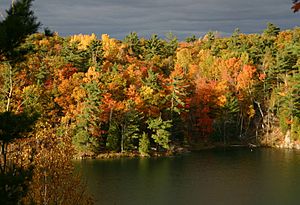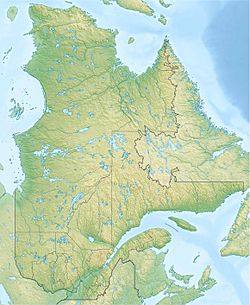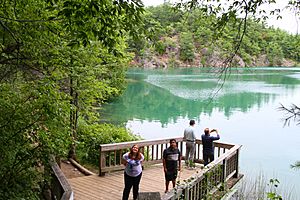Pink Lake (Canada) facts for kids
Quick facts for kids Pink Lake |
|
|---|---|
 |
|
 |
|
| Location | Gatineau Park, Gatineau, Quebec |
| Coordinates | 45°28′05″N 75°48′25″W / 45.46806°N 75.80694°W |
| Type | meromictic |
| Basin countries | Canada |
Pink Lake is a special kind of lake found in Gatineau Park, Quebec, Canada. It's called a meromictic lake, which means its layers of water don't mix together. This is quite rare!
During August and September, the lake's surface turns a deep green. This happens because there's a lot of tiny plant-like organisms called algae growing in the water.
Pink Lake is very delicate and needs protection. Human activities can harm it, leading to something called eutrophication. This is when too many nutrients enter the water, causing too much algae to grow, which can hurt other living things in the lake. To keep the lake healthy, park rules say no swimming, no pets near the water, no leaving the wooden boardwalk, and no throwing stones into the lake.
The Story Behind Pink Lake
Pink Lake got its name from an Irish family who settled nearby in 1826. They cleared land for a farm in the area.
Long, long ago, Pink Lake was actually part of the ocean and had salty water. It took over 3,000 years for the lake to slowly change from salty to fresh water. This is a very long time for a lake of its size! Because of this slow change, some of the fish that used to live in saltwater managed to adapt and survive in the new freshwater environment.
Unique Features of Pink Lake
Pink Lake is special because its water layers don't mix. This creates unique conditions that allow ancient forms of bacteria to thrive. These bacteria are amazing because they use sulfur instead of oxygen to make their food through a process similar to photosynthesis.
These special bacteria live in a layer about 7 meters (about 23 feet) from the bottom of the lake. This spot is perfect for them: it's deep enough to avoid the oxygen-rich water near the surface, but still shallow enough to get plenty of sunlight.
Pink Lake is also home to a unique type of fish called the three-spined stickleback. This fish usually lives in saltwater, but the ones in Pink Lake have adapted to live in freshwater. They are a special version that has lost its need for salt.
Scientists have also studied the layers of mud and sediment at the bottom of Pink Lake. These layers hold clues about what the weather and atmosphere were like over the past 10,000 years. By examining these annual deposits, researchers can learn about Earth's ancient climate patterns.



